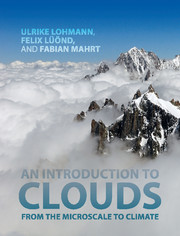Book contents
- Frontmatter
- Dedication
- Contents
- Preface
- List of symbols and acronyms
- 1 Clouds
- 2 Thermodynamics
- 3 Atmospheric dynamics
- 4 Mixing and convection
- 5 Atmospheric aerosol particles
- 6 Cloud droplet formation and Köhler theory
- 7 Microphysical processes in warm clouds
- 8 Microphysical processes in cold clouds
- 9 Precipitation
- 10 Storms and cloud dynamics
- 11 Global energy budget
- 12 Impact of aerosol particles and clouds on climate
- References
- Index
12 - Impact of aerosol particles and clouds on climate
Published online by Cambridge University Press: 05 June 2016
- Frontmatter
- Dedication
- Contents
- Preface
- List of symbols and acronyms
- 1 Clouds
- 2 Thermodynamics
- 3 Atmospheric dynamics
- 4 Mixing and convection
- 5 Atmospheric aerosol particles
- 6 Cloud droplet formation and Köhler theory
- 7 Microphysical processes in warm clouds
- 8 Microphysical processes in cold clouds
- 9 Precipitation
- 10 Storms and cloud dynamics
- 11 Global energy budget
- 12 Impact of aerosol particles and clouds on climate
- References
- Index
Summary
Aerosol particles affect the climate by scattering solar radiation and by absorbing solar and terrestrial radiation, as discussed in Chapter 11. In addition they modify cloud properties by acting as CCN (Chapter 6) and INPs (Chapter 8). These so-called aerosol–cloud interactions play a key role in the anthropogenic radiative forcing of the climate system (Boucher et al., 2013). They continue to remain the most uncertain of all forcing agents and are still associated with a low level of scientific understanding. The impact of aerosol particles on the radiative budget at TOA is expressed in terms of the radiative forcing (RF) as discussed in Section 12.1. The aerosol RF is negative and hence partly offsets the greenhouse gas warming.
Clouds have a large effect on Earth's radiative budget (Chapter 11). Vice versa, clear-sky radiative cooling and solar heating destabilize the atmosphere and thus drive convection and cloud formation. Also, the emission of longwave radiation from a cloud top destabilizes the air above it, allowing the cloud to grow vertically, while the absorption of solar radiation within the cloud can cause its dissipation. The climate impact of clouds depends on the altitude and the geographical locations where they form. These two aspects will be discussed in Section 12.2 together with the change in global cloud cover over the last 40–60 years.
The increase in greenhouse gases causes Earth's temperature to increase. In addition to the radiative forcing due to greenhouse gases, feedbacks also operate in the climate system in such a way that the water vapor mixing ratio increases or snow and ice melt. These changes in turn cause the temperature to increase even more; thus, they are positive feedbacks. How they work, and the role clouds play in a warmer climate, is the topic of Section 12.3.
Given that aerosol particles partly offset greenhouse gas warming, it has been suggested that aerosol particles should be deliberately injected into the atmosphere to cool the climate. This so-called climate engineering involving aerosol particles and clouds is discussed in Section 12.4.
Aerosol radiative forcing
Aerosol particles affect the climate directly by scattering and absorbing radiation as well as by modifying cloud properties, as shown in Figure 12.1 as quantified in terms of the RF in W m-2.
- Type
- Chapter
- Information
- An Introduction to CloudsFrom the Microscale to Climate, pp. 335 - 367Publisher: Cambridge University PressPrint publication year: 2016

